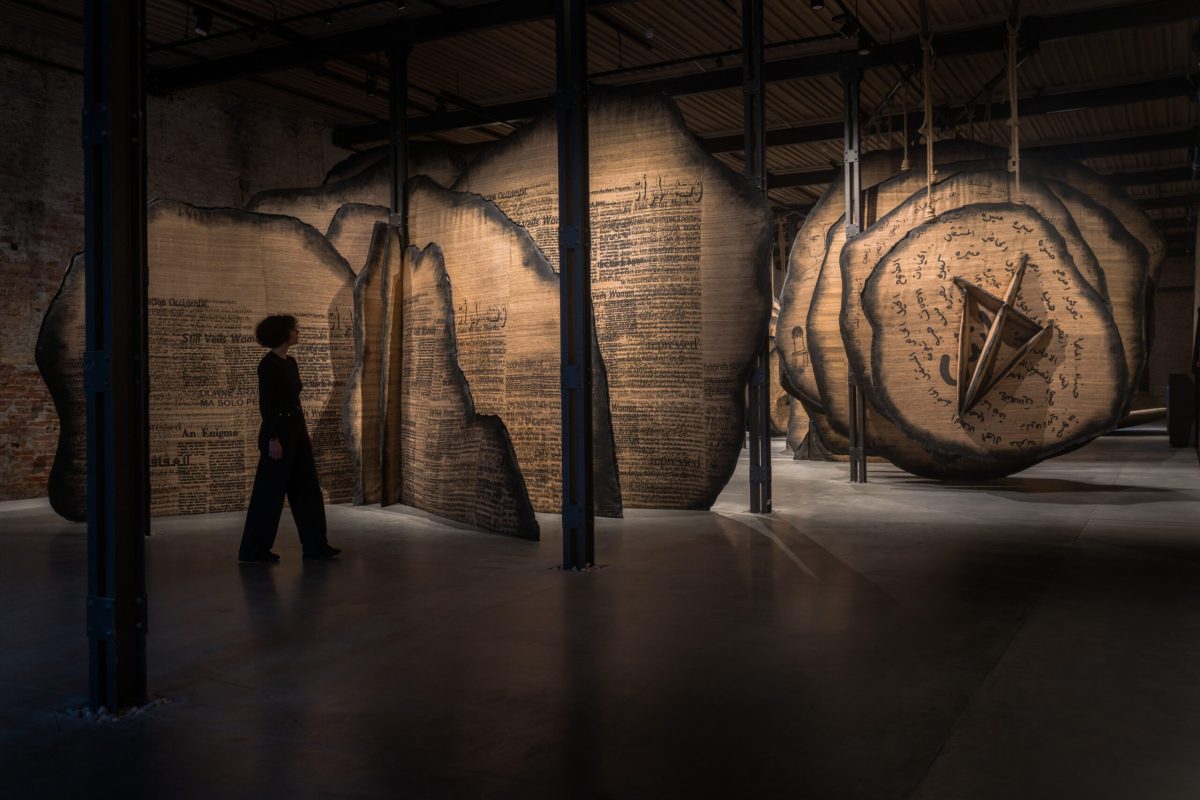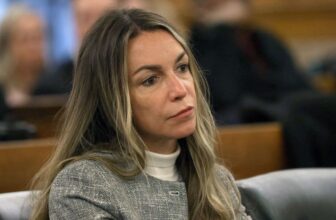
[ad_1]
The soft yet poignant sounds of harmonized humming emanate from the Saudi pavilion at the 60th Venice Biennale. They are the voices of around 1,000 women from the kingdom chanting in unison coupled with “singing sand dunes,” or the sound of wind whistling through Saudi Arabia’s Empty Quarter recorded by Manal AlDowayan. The artist staged three workshops with the women in Saudi Arabia for her exhibition, “Shifting Sands: A Battle Song,” which was curated by an all-female team for the Venice Biennale. The biennale opened April 20 and runs until November 24. It was curated by the Brazilian Adriano Pedrosa and is themed “Stranieri Ovunque – Foreigners Everywhere.” AlDowayan’s exhibition is one of four staged by Gulf Arab states in Venice that examine the past and present culture and history through art.
Inside the Saudi pavilion, larger-than-life, sand-colored circular panels rise from the floor stretching vertically to the ceiling. They recall the shape of the desert rose, which forms crystal-like clusters and grows in the arid desert landscape in Saudi Arabia’s Eastern Province, near where AlDowayan is from. Covering each panel are dozens of drawings and writings in Arabic and English professing statements such as “Let me be!”; “I am solidarity in the face of storms, I’m love in the face of dryness”; and “Thanks, we don’t need to be saved.”

The writings and drawings overlap various newspaper headlines depicting Saudi women as “repressed” and living in the “Dark Ages” that are rendered nearly illegible due to the material largely covering them. That, said AlDowayan, was the goal. “This work gives a voice to Saudi women to tell their story and reclaim their story,” AlDowayan explained. “The international press has enforced a narrative onto Saudi women.”
AlDowayan’s installation likens Saudi women to the desert rose that is formed under duress. After intense rainfall and extreme heat, the desert rose blossoms. The flowers, AlDowayan said, reflect the strength, power, and resilience of Saudi women during a time of change. “If one really wants to know the story of a people, specifically Saudi women, go to the center, go to the voice, go to the women,” she added.
The idea of breaking down stereotypes while upholding core facets of Arabian cultural identity is also present in Oman’s pavilion. The Gulf country is officially participating for the second time in the Venice Biennale after its first appearance in 2022. The pavilion, “Malath – Haven,” was curated by Omani artist Alia Al Farsi and celebrates Oman’s multicultural character and those who have long sought refuge in the country and transformed it into a mix of cultures.
The pavilion, located in Palazzo Navagero near Piazza San Marco, features marble sculptures by Ali al Jabri; an installation by Issa al Mufarji that merges Arabic calligraphy inspired by poetry; a video installation by Adham al Farsi, “The Fate of the Outsiders,” which tells the tale of turtles as a metaphor for foreigners in life; a sculpture of a niqab and video installation by Sarah al Olaqi, which seek to better introduce visitors to Omani culture and heritage; and a colorful wall painting by Alia Al Farsi, “Alia’s Alleys,” featuring Omani cityscapes.

Olaqi’s niqab – the piece of clothing traditionally worn by Arabian women to cover their faces – is made entirely of silver spoons. The spoons, explained Olaqi, serve as a metaphor for the collective strength and resilience of Omani women. “The piece aims to capture how Omani women have gracefully embraced their traditions while also navigating an increasingly changing world,” Olaqi said. “It also strives to break down stereotypes of women in the Gulf and portray them as empowered.”
“The niqab is a symbol of strength,” she added. “When you look at it, you might think it is oppressive, but women would wear it when they had to go out and work under the sun to provide for their families. It would protect them from the harshness of the heat.”
The Gulf states have only recently begun participating in the Venice Biennale, with the United Arab Emirates the first to exhibit in 2009. In 2011, the UAE exhibited in its permanent national pavilion inside the Arsenale, a complex of former shipyards and armories. Saudi Arabia made its first appearance in 2011, showing the work of Shadia and Raja Alem, and gained its own permanent pavilion in 2019. Kuwait participated in the 2022 biennale but is not participating this year. Bahrain, which participated in 2019, is also not present. Yemen participated once in 2016. While Egypt, in 1938, was the first Arab country to participate in the Venice Biennale and has a permanent pavilion in the Giardini, the Gulf Arab states now have a greater presence in the prestigious art show than Arab countries outside the Gulf.

The enrapturing beauty of the Arabian landscape is a focal point of the work of Emirati artist Abdullah Al Saadi in “Sites of Memory, Sites of Amnesia,” which was curated by Sharjah-based curator Tarek Abou El Fetouh for the UAE pavilion. The exhibition features eight introspective and delicately rendered notes and paintings on rocks and scrolls recounting Saadi’s journeys around the UAE through drawings, sculptures, paintings, and installations.
Based in Khorfakkan, Saadi is considered one of the pioneers of conceptual art in the UAE. “Traveling and understanding the world around me, especially nature, has always been a crucial part of my art,” Saadi said. “I hope visitors will think about their own travels and the place within the world they inhabit.” According to Fetouh, Saadi creates his art largely when he is immersed in nature, similar to Arab poets before him.
The show also delves deeper into the Arabian Peninsula’s collective memory. “Abdalla is not just documenting the landscape or creating out of nostalgia for pre-modern times in the Emirates,” said Fetouh. “The exhibition offers an attempt to create a subjective world that prompts a collective memory of the region.”
There is, Fetouh explained, like a traveler or foreigner in a familiar or unknown land, the idea of a dual journey – one within the metaphysical, subjective realm and the other in reality. “Abdalla remembers and depicts the landscapes each time in a different way,” said Fetouh.

While Qatar does not yet have an official pavilion, it is presenting in the biennale for the second time with “Your Ghosts Are Mine, Expanded Cinemas, Amplified Voices,” featuring 40 videos and films from Africa, the Arab world, and South Asia. The videos, which stem from the collections of Qatar’s Mathaf: Arab Museum of Modern Art and the Art Mill Museum, shed light on the personal and collective stories, conflicts, and challenges often underreported in the mainstream media.
The myriad challenges and issues facing the world were also the subject of “When Solidarity Is Not a Metaphor,” a group show staged by the Dubai-based Alserkal Initiative in collaboration with France’s Cité internationale des arts, which ran until April 21. The show presented works by artists who reflected the idea of solidarity in their art during a time of mounting sociopolitical and environmental crises. The works of art, through images and expressions of pain and upheaval, showed how solidarity is not a one-time act. Like presentations by other Gulf states seeking to dispel misperceptions while upholding cultural heritage and depictions of national identity, artwork can be a vehicle to redress narratives and stereotypes and, as the show emphasized, champion awareness and call viewers to action.
“Solidarity is an ageless, ongoing expression of feeling – and being – with someone or a group that experiences injustice,” said curator Natasa Petresin-Bachelez. “It is related to the core of any sense of humanity: Without compassion, there is no solidarity.” Humanity, said Petresin-Bachelez, is composed of “foreigners everywhere.”
Contemplating forms of solidarity and new narratives during a time of great polarization and upheaval through art offers ways forward. As imperfect as these forms are, they offer, as Petresin-Bachelez said, “The concept of humanity everywhere.”
[ad_2]





